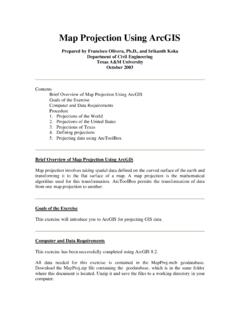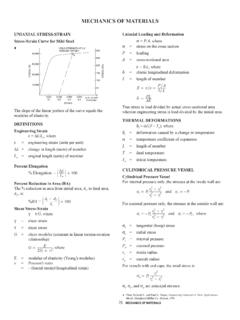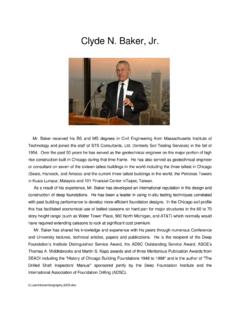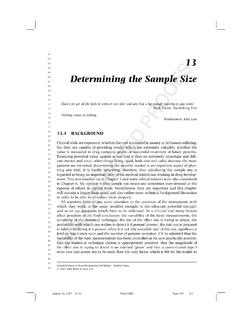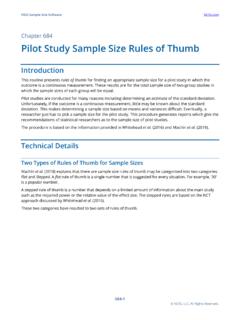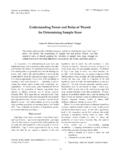Transcription of Procedures for Determining a Soil’s Water Content
1 Procedures for Determining a soil s Water Content Laboratory determination of Water Content of soil and Rock D2216-92 Abstracted, with permission, from the 1996 Annual Book of ASTM Standards, copyright American Society for Testing and Materials, 100 Barr Harbor Drive, West Conshohocken, PA 19428-2959 Scope This test method covers the laboratory determination of the Water Content of soil rock, and similar materials by mass. The Water Content of a material is defined by this standard as a ratio, expressed as a percentage, of the mass of pore or free Water in a given mass of material to the mass of the solid material.
2 This standard requires the drying of material in an oven at high temperatures. Summary of Test Method The test specimen is dried in an oven to constant mass. The loss of mass due to drying is considered to be Water in the soil pores. The Water Content is calculated using the mass of Water and the mass of the dry specimen. Significance of Use For many materials, the Water Content is one of the most significant index properties used in establishing a correlation between soil behavior and its properties. The Water Content of a material is used in expressing the phase of relationships of air, Water , and solids in a given volume of material.
3 In fine-grained (cohesive) soils, the consistency of a given soil type depends on its Water Content . The Water Content of a given soil , along with its liquid and plastic limits as determined by Test Method D 4318, is used to express its relative consistency or liquidity index. Apparatus The following items are required for this testing method: 1. A thermostatically controlled oven, preferably of the force-draft type capable of maintaining a uniform temperature of 110 5 C throughout the drying chamber. 2. A balance with a readability of g 3. Specimen containers for drying.
4 4. Container handling devices. 5. Miscellaneous items such as knives, spatulas, scoops, etc. samples samples shall be stored in jars or other containers in such a way as to prevent or minimize moisture condensation on the insides of the containers. Test Specimen The minimum mass of moist martial selected to be representative of the total sample, if the total sample is not tested by this method, shall be in accordance with the following: Max Particle Size (100% passing) Standard Sieve Size Minimum Mass of Moist Test Specimen for reporting Water Content to Minimum Mass of Moist Test Specimen for reporting Water Content to 1% 2 mm or less No.
5 10 20g 20g mm No. 4 100g 20g mm 3/8 in. 500g 50g mm 3/4 in. 250g mm 1 1/2 in. 10kg 1kg mm 3 in. 50kg 5kg If the total sample is used it does not have to meet the minimum mass requirements provided in the table above and the report shall indicate that the total sample was used. If a sample smaller than the minimum is used then it must be stated in the report. Test Specimen Selection When the test specimen is a portion of a larger amount of material, the specimen must be selected to be representative of the Water condition of the total amount of material.
6 The manner in which the test sample is selected depends on the purpose and application of the test, type of material being tested, the Water condition, and the type of sample (from another test, bag, block and the likes). If disturbed samples such as trimmings, bag samples and the likes are being used, obtain the test specimen by one of the following methods: 1. If the material is such that it can be manipulated and handled without significant moisture loss, the material should be mixed and then reduced to the required size by quartering or splitting. 2. If the material is such that it cannot be thoroughly mixed and/or split, from a stockpile of the material, mixing as much as possible.
7 Take at least five portions of the material at random locations using a sampling tool and combine all portions for the test specimen. 3. If the material or conditions are such that a stockpile can not be formed, take as many portions of the material as possible at random locations and combine all the portions for the test specimen. For intact samples such as block, tube, split barrel, and the like, obtain the test specimen by the following method: Carefully trim at least 3 mm of material from the outer surface of the sample to see if the material is layered and to remove material that is drier or wetter than the main portion of the sample .
8 Then carefully trim at least 5 mm, or a thickness equal to the maximum particle size present, from the entire exposed surface from the interval to be tested. Procedure 1. Determine and record the mass of the clean and dry specimen container (and its lid if used). 2. Select a representative test specimen. 3. Place the moist test specimen in the container and, if used, set the lib securely in position. 4. Determine and record the mass of the container and the moist material. 5. Remove the lid (if used) and place the container with moist material in the drying oven.
9 Dry the material to a constant mass. Maintaining the oven at 110 5 C unless otherwise specified. The time required for obtaining a constant mass may vary depending on the type of material, size of specimen, and oven type as well as other factors. The influence of these factors generally can be established by good judgment, and experience with the material being used and the apparatus being used. 12 to 16 hours should be sufficient. 6. After the material has been dried to a constant mass remove the container from the oven (and replace the lid if used). Allow the material and container to cool to room temperature or until the container can be handled comfortably with bare hands and the operation of the balance will not be affected by convection currents and/or its being heated.
10 Determine and record the mass of the dried sample and the container using the same balance. Calculation Calculate the Water Content of the material as follows: ()()100100 = =swccscscwsMMMMMMw where: w = Water Content , %, Mcws = mass of container and wet specimen, g, Mcs = mass of container and oven dry specimen, g, Mc = mass of container, g, Mw = mass of Water , g, and Ms = mass of solid particles. Report The report and data sheet shall include the following: 1. Identification of the sample and material being tested, such as boring number, sample number, test number, container number etc.

